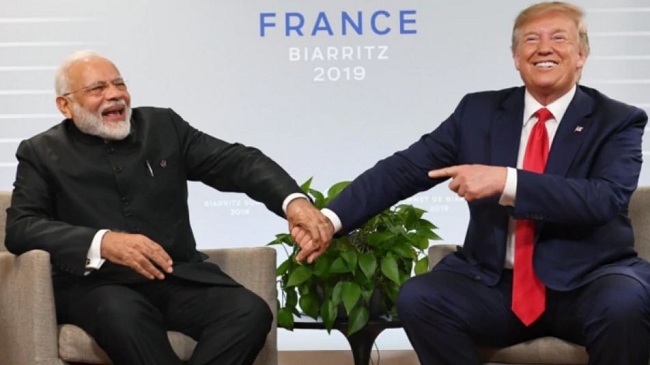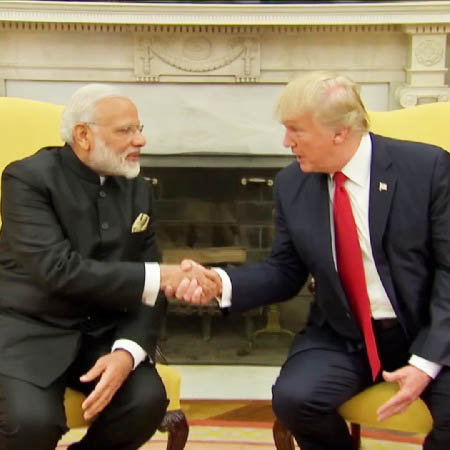The last few years have seen the world's two superpowers- the United States of America and India- evolve as allies. The reason for the alliance could be the threat both the nations face from the ever-rising military and economic development of China or the growing closeness between their two leaders: Donald Trump and Narendra Modi.
Earlier, in April 2020, tensions arose after India decided to stop the export of Hydrochloroquine- a possible medicine to cure the COVID-19- in March 2020. Trump even threatened India with retaliation if the said drugs were not released. However, once the charming Prime Minister of India, Narendra Modi, agreed to uplift the ban, the two national leaders seem to be on the same path.
P.M. Modi and President Trump have followed the same ideology of "nationalism" to boost their political agendas. While Donald Trump rose to power after winning the U.S. Presidential Election in 2016, promising to build a wall around the states to keep illegal immigrants out, Modi became the Indian Prime Minister after winning the General Election in 2016. He had earlier served as the Chief Minister of the Indian state of Gujarat from October 2001 to May 2014.

Indian Prime Minister Narendra Modi and U.S. President Donald Trump in 2019 (©: IndiaToday)
It was during his term as the Chief Minister of Gujarat in 2005 that Modi was denied a U.S. diplomatic visa. What was the root cause of the rejection by U.S. officials? The reason was his injustice towards the minority communities in Gujarat!
Incompetence/Unwillingness To Stop Religious Violence In Gujarat?
On 27 February 2002, a train named Sabarmati Express was returning to Ahmedabad- a city in Gujarat, India- from the Hindu holy city of Ayodhya. Reports claim that after the train stopped at the Godhra railway station, some Hindus exited the train and started harassing Muslim vendors at the platform; they asked the vendors to chant Hindu religious hymn (Jai Shree Ram), which the Muslims protested.
A turmoil ensued soon after, and four coaches of the Sabarmati Express were set on fire- which caused the death of 59 people, mostly women, and children.
Enraged by the deaths of the people, the Hindu majority population took law on their own hands under the leadership of the then-head of Gujarat's branch of Bajrang Dal (a Hindu organization), Babu Bajrangi. The violence took over 2000 lives as claimed by witnesses and co-conspirators, but the government only declared 1044 deaths.
It was reported that many police officials were present at the riot spots- including the Gulbarg Society in Ahmedabad and Naroda Patiya- during the time of the violence but did nothing to save the innocents as, according to the police, they had no orders to save the Muslim mass.

A scene of the Gujarat riots in 2002 (©: HWnews.in)
The Indian army and special forces were deployed only after 72 hours of the initial violence against the Muslim community, which brought the then-Chief Minister of Gujarat Narendra Modi's reign under questions. The visa rejection by the U.S. in 2005 was also based on his inaction to control the religious violence in his state. He was declared ineligible for a U.S. diplomatic visa for being a government official who violated the religious freedom of others.
Later, though some of the accused were sentenced to years in prison and 11 were sentenced to life imprisonment in 2016, Narendra Modi was eventually acquitted by the Supreme Court of India. A key accused had even claimed on tape that Narendra Modi agreed on 28 February 2002 to refrain from using the security forces for three days, which gave the hooligans freedom to use any form of violence against the Muslim people. Further, even Babu Bajrangi- one of the main accused of the massacre- had claimed that Modi was the one who bailed him out after he was arrested.
Likewise, the ban on Modi from entering U.S. territories was also lifted once he was elected the Prime Minister of India in 2014. He traveled to the U.S. in the same year and even had a private dinner with the then-United States' President, Barack Obama.
What's The Next Move For PM Narendra Modi?
After his reinstatement as the Prime Minister of India in 2019, Modi has furiously advocated for nationalism and has promised to work for the eradication of poverty in India. Though his policies look beneficial for the Indian people, Modi's affiliation with a Hindu organization named Rashtriya Swayamsevak Sangh (RSS) or National Volunteer's Organization (in English) has troubled some due to the organization's extreme ambitions.
Some claim that it was RSS, which helped Narendra Modi secure his position as the Prime Minister twice and that Modi is merely a puppet of the organization. RSS- which advocates Hindutva (Hindu values)- has vowed to establish India as a Hindu nation, and many members of the said organization have also given rousing statements asking the government to exile people of other religions from India. Further, the Bharatiya Janata Party (BJP)- the ruling party of India- is also seen as a Hindu-majority party with ambitions to bring back the glory days of the mythical ancient Hindu civilization.
Reports reveal that many such fanatics in India believe it should conquer neighboring countries like Nepal, Bangladesh, Pakistan, and Sri Lanka under the Akhanda Hindu Rastra Bharat (United Hindu Nation India) campaign.

The territories and ideologies of Akhanda Hindu Rastra Bharat (United Hindu Nation India) (©: HariBhakt)
And, with the support of the majority of the population in India, added with political instability and disunity among the people of the said nations, the task to conquer the countries doesn't seem like a tough job, either for Modi or the RSS.
After taking over the disputed state of Jammu & Kashmir and introducing the controversial Citizen Amendment Act- which grants Indian citizenship to refugees of many religions except Muslims- in 2019, it seems like the BJP-ruled India is on the way to exterminate anyone not complying to Hindu religious beliefs and lifestyle.

